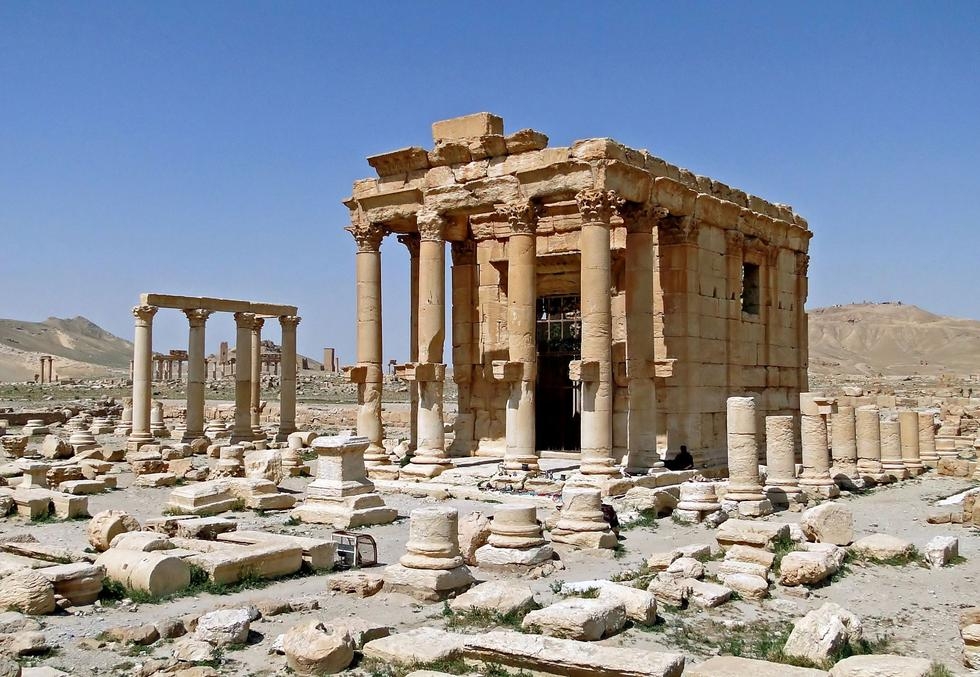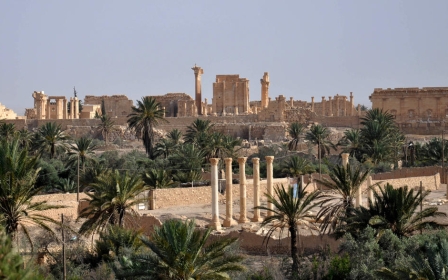Syria’s treasures are being smashed – but we will rise again

Strolling behind the Grand Umayyad Mosque one finds a melange of shabby antique shops dotted across the meandering cobbled alleys of Old Damascus. Once they were frequented by tourists and the city’s cultured elite. The shops are dark - electricity is off most of the day and the sound of generators is so strong that it drowns that of the mystic azzan of the hundreds of mosques of Old Damascus.
Some of what the antique dealers have on display was smuggled from Baghdad to Damascus after the 2003 invasion of Iraq. Former customers have long left the country and those who remain have no appetite for Ottoman ornaments, Persian rugs or French furniture. The tourists, of course, have all disappeared. Magnificent Italian silverware, once served at the palaces of Iraq’s boy-king Faisal II, was recently sold for $100. The cups and saucers are adorned with the gold emblem of the Royal Hashemite family of Iraq. An original portrait of Sultan Abdulhamid II is also on sale with a breathtaking Mother of Pearl frame. It used to decorate one of the government buildings of Ottoman Damascus prior to World War I. The frame is over 100-years old. It sold for $75.
One only wonders what the fate of Damascus treasures will be once the guns go silent in Syria. They are bound to be in high demand in Vienna and Paris, or Istanbul and Beirut. Some are already on sale in Damascus. The original sketches of artist Khaled al-Asali, for example, who created the emblem of the Syrian Republic back in 1932, recently sold for $10. Abandoned Syrian homes have been looted and their furniture is now up for sale at an illegal market ironically called Souq al-Haramiya (Market of the Thieves).
The priceless gold treasures of the city, however, are held under lock and key in Damascus - still out of harms’ way. Real worry, however, is now focused on the ancient city of Palmyra, which fell into the hands of Islamic State terrorists on 21 May. If it is destroyed, it would spell out disaster for Syria and for the world at large. Iconised by humanity at large, Palmyra is a UNESCO World Heritage Site dating back to the early second millennium BC. The ancient city, mentioned in the Old Testament, was vital for caravan routes along the Silk Road. Its temples are dedicated to Aramean, Babylonian and Mesopotamian deities - all of which are now under threat of being smashed by IS.
We've been here before
The so-called “Islamic” terrorists did it before in March 2001, when the Taliban destroyed the ancient Buddhist statues of Bamiyan in Afghanistan. More recently last February, IS released a five-minute video of its warriors at the Mosul Museum smashing ancient statues into tiny fragments, dating back to the Assyrian and Akkadian Empires. In the video, another man is shown drilling through the statue of a winged bull, an old Assyrian deity, dating back to the 7th Century. At the time of writing, the Palmyra Museum has reportedly been completely evacuated, but nobody knows what will happen to the city’s historic columns, its Roman aqueduct, its famous theatre, or necropolises.
Before this war started, Syrians were never that good at maintaining their archive, and as a result, much of it was stolen and smuggled prior to the war, left to fall into a state of decay over the past four years, or destroyed by the violence that has engulfed Syria. At the Syrian Parliament, for example, all the official minutes of the years 1919-2005 were bundled into trucks and shipped out to the Damascus countryside - supposedly for safekeeping. They have since vanished. The hand-made magnificent bureau of Prime Minister Fares al-Khoury - a legendary founder of the Syrian Republic - survived from 1944 until the mid-2000s. It too has evaporated into thin air, and so have all audio records of historic parliamentary sessions from the 1940s and 1950s.
Even worse is the condition of the Damascus Museum for Historical Documents, located in the splendid mansion of ex-Prime Minister Khaled al-Azm, on the edge of the 800-year-old Souq Saruja neighbourhood. Not too long ago, students literarily lived at its reading rooms, rummaging through old newspapers and Ottoman-era documents. Tourists walked in occasionally to take a picture before the palace’s gushing water fountains and brimming lemon trees. The place is now almost a ghost house; its breathtaking rooms have been compartmentalized; rented out to different government agencies. Neglect has eaten away at its corners; dust covering its beautiful furniture. Careless archivists, who receive a salary of no more than $50 per month, yawn behind their desks, combating boredom by filing their nails and sipping strong black tea. A window pane collapsed at the Damascus Museum. Instead of fixing it, the negligent staff decided to cover the big hole with a stack of old books and documents, exposing them to wind and rain. One paper, stitched together by scotch tape, was a letter from Charles de Gaulle to then-President of Syria, Taj al-Din al-Hasani, dated September 1941. Syria’s audio-visual library is also in danger. Thousands of historic black and white reels were carelessly stored in the Damascus countryside many years ago, exposed to both rain and sunlight. They have all been destroyed by the battles of Sbeineh, a village in the al-Ghouta orchards. Nobody knows for sure what exactly the huge crates of film contained, and sadly, nobody ever will.
Architectural decay
Walking through the Old City of Damascus, once the gem of the entire East, one is appalled by the amount of visual pollution and architectural decay. Many of the city’s old mansions are crumbling, like the palace of Abdul Rahman Pasha al-Yusuf, the emir of hajj who led pilgrims annually from Damascus to Mecca. He was reportedly the richest Arab in the Ottoman Empire. His 2,500 square-metre palace in Souq Saruja was once a sight for sore eyes. Its courtyard is now destroyed and so is the liwan, having collapsed completely, with its carved Mosaic doors and dazzling Oriental architecture.
The same applies to the palace of Syria’s first President Mohammad Ali al-Abed also in Souq Saruja. Half of it is in shambles while the other half has been transformed into a shoe-making workshop. In the al-Amara neighbourhood, behind the Grand Umayyad, the residence of the 19th century Algerian resistance leader Emir Abdul Qader al-Jazairi is also in very poor condition, with entire sections now reduced to dust and rubble.
Many of the city’s old mansions, transformed into boutique hotels and restaurants prior to the war, have now either closed down or morphed into refugee centres or “charity” hotels, offering a night for $15 when previously, the tourist rate stood at $300/night. The number of residents of the Old City has quadrupled. Entire towns and villages around Damascus have gone ablaze, after all, forcing many of their residents to find lodging in Old Damascus. Many of these families now rent common space for accommodation, which leaves them with no bathrooms or showers. This has forced many to regularly visit the old Turkish baths of the city. The ancient hammams, once nothing but a tourist attraction, have been re-born because of the war as entire families visit them weekly once again, just like they used to 100-years ago.
The destruction of course, is everywhere, and Damascus is the city to suffer least damage since 2011. An ancient Maronite church, located 40 km north of Aleppo, has been destroyed and so has the 15th century Armenian Church of Forty Martyrs. In fact most of the ancient city of Aleppo has been eradicated by the ongoing violence. In September 2014 the Islamic State shattered the Armenian Genocide Memorial Church in Deir ez-Zour. The stunning National Hospital of Aleppo has been flattened, and so have its ancient souqs and the city’s divine 8th century Grand Umayyad Mosque.
The marvellous Khaled Ibn al-Walid Mosque of Homs in central Syria has also been ravaged. In 2013, Jabhet al-Nusra rebels beheaded a statue of Abbasid-era poet and philosopher Abu Alaa al-Maari in northwestern Syria. The statue of Ibrahim Hananu, leader of the anti-French resistance in the early 1920s, was also recently decapitated in Idlib by Islamic rebels. Surprisingly the Umayyad Mosque of Damascus has emerged unharmed, with the exception of one minor incident in 2013 when rebel mortars from the Damascus countryside smashed its stained and latticed windows, which are over 1,300 years old.
Damascus has seen all this before, in different times, with different magnitude, and different players. The city was bombed in 1260, 1401, and 1831. French colonialists once savagely bombarded the city for 48-hours non-stop, back in 1925. Over 150 beautiful mansions were destroyed, and so was the great Azm Palace, home of the city’s 18th century governors. The Midhat Pasha and Bzurieh Market were ransacked and the roof of the Hamidieh Market was completely blown off.
The city was bombed by the French yet another time in 1945, this time destroying its historic citadel and Parliament. Palmyra itself was completely destroyed by the Romans in 273 and - much later - witness to intensive battles between European armies during World War II in July 1941. Beneath the layers of fear and despair, there is always room for hope. Nothing lasts forever. This is the golden rule of life by which the Syrians swear. One day, this war will end. Cities like Damascus and Palmyra, they say, which have seen so much horror in their lives, will certainly rise from the ashes.
Syria always has, every single time, for more than 10,000 years.
- Sami Moubayed is a Syrian historian and former Carnegie scholar. He is the founder of the Damascus Foundation for Historical Studies and author of “Syria and the USA” (IB Tauris, 2012).
The views expressed in this article belong to the author and do not necessarily reflect the editorial policy of Middle East Eye.
Photo: Roman Temple of Baal Shamin in Palmyra has been damaged during the war (Wikicommons)
Middle East Eye propose une couverture et une analyse indépendantes et incomparables du Moyen-Orient, de l’Afrique du Nord et d’autres régions du monde. Pour en savoir plus sur la reprise de ce contenu et les frais qui s’appliquent, veuillez remplir ce formulaire [en anglais]. Pour en savoir plus sur MEE, cliquez ici [en anglais].





